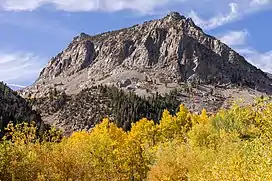Mount Scowden
Mount Scowden is an 11,182-foot-elevation (3,408 meter) summit located in the Sierra Nevada mountain range, in Mono County of northern California, United States.[1] The mountain is set less than three miles east of the Sierra crest, within the Hoover Wilderness, on land managed by Inyo National Forest. Mount Scowden is situated in Lundy Canyon, one mile north of line parent Tioga Crest, 1.6 miles (2.6 km) west of Gilcrest Peak, and 2.5 miles (4.0 km) southeast of Black Mountain. Topographic relief is significant as the summit rises 2,900 feet (880 meters) above Mill Creek in one mile. Precipitation runoff from this mountain drains to Mill Creek, and ultimately Mono Lake. The mountain's toponym has been officially adopted by the United States Board on Geographic Names and has been in publications since at least 1882.[1][4] Leo A. Scowden (born 1848) was a mining engineer and United States deputy mineral surveyor for California who resided in Bodie, Mono County.[5][6][7] There were several mining claims on Mt. Scowden in the 1800s which gave rise to the gold rush camp of Lundy.[8]
| Mount Scowden | |
|---|---|
 Northeast aspect | |
| Highest point | |
| Elevation | 11,182 ft (3,408 m)[1] |
| Prominence | 123 ft (37 m)[2] |
| Parent peak | Tioga Crest (11,911 ft)[2] |
| Isolation | 1.04 mi (1.67 km)[2] |
| Coordinates | 38°00′30″N 119°15′37″W[1] |
| Geography | |
 Mount Scowden Location in California  Mount Scowden Mount Scowden (the United States) | |
| Location | Mono County, California, U.S. |
| Parent range | Sierra Nevada |
| Topo map | USGS Dunderberg Peak |
| Geology | |
| Age of rock | Triassic to Permian |
| Type of rock | Andesite, Metavolcanic rock[3] |
Mining
Gold and silver mining claims on Mt. Scowden:[9]
- May Lundy
- Homer
- Harrison
- Last Chance
- Lucky Mortan
- Bay Queen
- Bryant
- Gray Eagle
- Gorilla
- Parrott
- Tamarack
- Wolverine
- Mono
- Ontario Syndicate
Climate
Mount Scowden is located in an alpine climate zone.[10] Most weather fronts originate in the Pacific Ocean, and travel east toward the Sierra Nevada mountains. As fronts approach, they are forced upward by the peaks (orographic lift), causing moisture in the form of rain or snowfall to drop onto the range.
See also
Gallery
References
- "Mount Scowden". Geographic Names Information System. United States Geological Survey, United States Department of the Interior. Retrieved 2022-05-10.
- "Scowden, Mount - 11,180' CA". listsofjohn.com. Retrieved 2022-05-10.
- United States Geological Survey (1983)
- Pacific Rural Press, Volume 23, Dewey & Company, April 8, 1882, p. 258
- Annual Report of the Commissioner of the General Land Office for the Fiscal Year ending June 30, 1879, Washington: Government Printing Office (1879), p. 432
- The Engineering and Mining Journal, December 3, 1898, p. 674
- Annual Report of the Secretary of the Interior, U.S. Government Printing Office, (1879), p. 703
- Mining and Scientific Press, February 17, 1900
- Jerry Grant (2020), Grants Mining Districts of the Western United States, Xlibris US, ISBN 9781664146914
- "Climate of the Sierra Nevada". Encyclopædia Britannica.
External links
- Weather forecast: Mount Scowden



